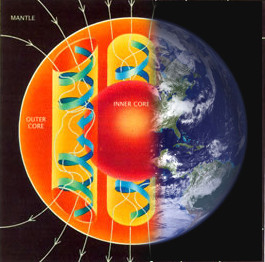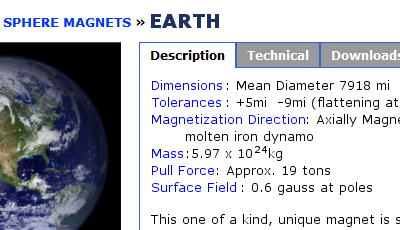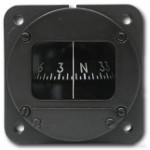The Earth acts like a very big, weak magnet -- that’s why compasses point north! In this article, we explore a few interesting facts about Earth’s magnetic field, including a few ways to play with it using neodymium magnets.

Earth’s magnetic field is mostly caused by electric currents in the liquid outer core, which is composed of conductive, molten iron. Loops of currents in the constantly moving, liquid iron create magnetic fields.
From afar, the Earth looks like a big magnet with a north and south pole like any other magnet. (As described in Which Pole is North, the pole located up in northern Canada is really the magnetic south pole.) If we consider it like a magnet, how does it compare to a magnet you might hold in your hand?
As described in our article on Magnet Grades, we often describe the strength of a magnet in two different ways: the strength of the magnetic field around it (surface field, expressed in gauss) and the force it takes to remove a magnet from either a steel plate or another magnet (pull force, expressed in pounds). How would we specify the Earth?
Our S8 sphere magnet has a field strength of over 8,000 gauss near the poles of the magnet. Stuck to a steel surface, the pull force is about 6.5 lb. What would the earth’s specs be?
The strength of the Earth’s magnetic field at the poles is around 0.6 gauss – much weaker than a neodymium magnet!

For fun, we made a rough estimate of what the pull force of an Earth magnet would be, by making a big list of questionable assumptions. If we assume the Earth is a permanent magnet instead of a ball of half-molten iron with electrical currents running through it, we might figure Brmax is about 1 gauss. That’s a lot weaker than the Brmax of 13,200 gauss for a grade N42 magnet like the S8.
If you could find the largest refrigerator door in the universe to stick Earth to, we made some more rough calculations to figure it might have a pull force of about 19 tons. That sounds like a lot, but not so much when you consider the Earth has a mass of about one thousand trillion tons. The forces from gravity pulling it towards this huge refrigerator door would probably completely overshadow any magnetic forces.

Standing on the surface of the Earth, we can use a magnet or magnetized object to act as a compass. Measuring the direction of the magnetic field has been a great way to tell the direction for almost a thousand years.
How does it work? The needle of a compass is actually a magnetized piece of metal. Carefully balanced, it tends to move to align itself with the local magnetic field. When it isn't pointed north, magnetic forces tend to push it towards that direction. The forces are very weak, but with a low-friction compass, they are enough to get the job done.
Note that a compass tends to point to the magnetic north pole, which is different than the geographical north pole where all the lines of longitude meet. The difference between the direction to the geographical north pole and where a compass is pointing is called declination.
Not only can a magnetized needle work as a compass, but a magnet can as well. Our favorite trick is to balance a disc magnet on edge, and let it spin to point to the north pole. We showed this before in our article about identifying the poles of a magnet. Here, see a similar demonstration with our red and black, plastic coated magnets.
The actual direction of the magnetic field at a particular location on the Earth isn’t always level with the ground. In fact, here at our Pennsylvania, USA location, the direction is pointed more towards the ground. The amount that the field direction isn’t level is called the inclination. According to the map at right, we see a magnetic field pointing towards the magnetic north pole here, but also pointing down towards the ground at about 67 degrees. Your inclination will vary depending on your geographical location. Most of North America ranges from 40 to 70 degrees.
The video below demonstrates how to visualize this in two different ways. First, we roll a sphere magnet around on a flat, non-metallic desk. It always stops with the magnet’s north pole pointing down at an angle! Picture a big arrow running through the axis of the sphere magnet, pointing down into the ground. That's the direction of the local magnetic field.
The second demo uses a diametrically magnetized ring magnet, which rolls across the desk unevenly. The magnet rolls to align itself with the local magnetic field, with the north pole pointing down at a sharp angle.
Interestingly, the north pole doesn’t sit still. It tends to move around quite a bit, even from year to year. Over the last 180 years, the North Magnetic Pole has been migrating northwestward.
Over longer periods of time, the location of the poles can move so much that the north and south poles can switch locations. There is evidence that these magnetic field reversals have happened at various times throughout history. Evidence for these events can be found worldwide in basalts, sediment cores taken from the ocean floors, and seafloor magnetic anomalies.
When these rocks formed, bits of iron oxide inside them were magnetized and aligned themselves with the earth’s magnetic field at that time and place. By measuring the alignment of these particles, a history of these magnetic field reversals can be read in the seafloor (among other places).
In fact, the stripes of alternating magnetization directions along the seafloor measured in the 1960s and 1970s was the needed proof to validate the theories of continental drift and plate tectonics.
For a demonstration, we sprinkled some iron dust on a surface and moved a magnet near it. While you can purchase iron oxide like this from some hobby or science stores, you can also make a little by grinding a piece of steel or iron with a file. Sorry, we don't offer iron filings for sale!
In the video below, you can see how the iron particles align themselves with the magnetic field.
In space, the earth’s magnetic field does some really important things that we don’t often think about. While it’s hard to come up with some experiments to show these effects here on Earth’s surface, it’s still pretty interesting stuff.
The solar wind is a stream of charged particles that flow outward from the sun, made up of mainly electrons and protons. Earth’s magnetic field shields the surface of the earth from most of these particles in a region known as the magnetosphere. Its shape constantly shifts and changes in response to the solar wind.
Where some of these charged particles sneak in past the magnetic field, we see aurora – the Northern (and Southern) Lights.
Of course, the magnetosphere is important to us for more than providing pretty light shows to people living near the poles. Scientists figure that if there were no magnetic field, the charged particles of the solar wind would strip away the ozone layer, which helps block UV light rays from the sun. Even more drastically, evidence suggests that this lack of a magnetic field is why Mars has so little atmosphere – it was stripped away over time since the Martian magnetic field turned off.